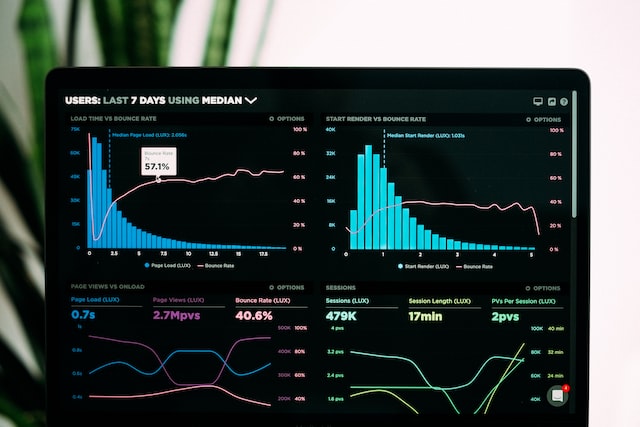Marketing Metrics that Matter: What to Measure and Why

Effectively measuring your progress is essential in both your personal and professional life. Whether you’re tracking how much weight you lift or if you’ve reached your quota for your outreach campaign, tracking results can help you improve in the long run.
In the world of marketing, metrics are a critical aspect. It might sound like an exaggeration, but you can’t conduct a marketing campaign correctly without collecting the right data. As much as 89% of leading marketers are tracking complex metrics such as market share and gross revenue to reach their goals.
No matter the type of your business, it’s important to make your marketing campaigns as effective as possible. This is achievable by tracking data such as website traffic, bounce rate, and engagement, and working on improving those numbers. Key Performance Indicators (KPIs)
Key Performance Indicators are the objective measurement of the performance of marketing campaigns. They help individuals and teams get an insight into whether they are making enough progress for them to reach their goals.
SaaS marketing companies set a specific KPI for each one of their teams, so they can track the efficiency of campaigns. Also, they can take action if some of their employees or teams aren’t meeting their goals.
For example, you can ask your employees to do work for a number of hours during a week, but the time spent on tasks doesn’t guarantee success. Instead, by setting a weekly or a monthly KPI goal, their results are much easier to track.
Common examples of KPIs are:
- Customer lifetime value,
- Customer acquisition cost
- Sales revenue
- Conversion rate
But also some metrics that aren’t as straightforward to track, such as brand awareness. If we take the metric of the customer acquisition cost, we can understand the effectiveness of marketing campaigns targeted toward potential customers.
For example, the customer acquisition cost is measured by dividing the total cost of a marketing campaign by the total number of new customers. If the number is too small or too large, you can then understand whether you’re investing too much money for a poor outcome.
Marketing Channels and Metrics

When you’re conducting marketing, you wouldn’t want to rely on one channel to attract new customers. While there are some products and services that would attract a specific group, it’s best to try out multiple types of marketing and see which one works the best.
Social media platforms, for example, have people of different age groups using them. TikTok is used by teenagers and young adults, while Facebook and Twitter have older audiences. By tracking the engagement with your content on multiple platforms, you can choose the one that’s bringing you the largest amount of traffic.
The same idea can be applied on a greater scale. Try out attracting customers through SEO, social media, and ads, and see which of those methods is the most effective.
Website Traffic
Every business should have a website, as it provides potential customers with all the required information on the product or services. It’s also much easier to reach a company if its contact information is neatly placed on its website.
Website traffic shows the total number of visitors. The downside of this metric is that some of those visitors are actually bots. However, to get some useful information out of this metric, you should dive deep into the following:
- Sources of traffic
- Session duration
- User Engagement
Online businesses, such as e-commerce stores, depend on increasing their website traffic as every new visitor can be a potential customer.
It’s important to understand where your traffic is coming from. To analyze this, you can utilize Google Analytics, or if you’re using an e-commerce platform such as Shopify, some of its analytical plugins.
If you have a blog, you should expect that you’re receiving visitors from search results. Doing proper search engine optimization can do wonders for your traffic. But many businesses rely on having a good social media campaign or pay-per-click ads to bring traffic to their website.
Social media following

There’s a plethora of social media platforms where you can conduct your marketing campaigns. Some of them have internal analytical tools that can be used to track engagement and run marketing campaigns. If they don’t, you can try out some external SMM tools.
The most common marketing metrics on social media are reach and engagement. Reach is the number of people who saw your ad or a post and aren’t necessarily your followers.
Engagement is quite important as it represents the number of people who have liked, commented, and shared your content. If this metric is low, it can mean that your social media strategy needs to be revised.
PPC advertising
If you’re looking to speed up the process of getting new customers or clients, you can look into pay-per-click advertising. This is a form of digital advertising where you’re paying each time a user clicks on your ad. There are many PPC networks you can choose from, the most popular being Google AdSense, but you can run ads on Instagram and Facebook.
Metrics related to PPC advertising that you should track are
- Click-through rate
- Cost per click
- Conversion rate
These numbers can help you track your PPC campaigns more effectively. Click-through rate represents the number of clicks that are divided by the number of times it was displayed. If this number is low, you might want to implement a better call-to-action or make the ad more appealing.
Cost per click is the amount of money that you pay every time a person clicks on the ad. Depending on the PPC network, the payment process can function in a couple of different ways.
You can set a daily or weekly budget, and the ad will stop running after your budget for the time period is spent. The price of each click usually depends on the popularity of the keywords and their relevance.
Your end goal is to draw attention to your product or services and motivate them to make a payment. Conversion rate is the metric that tracks how many people convert from visitors to customers. If this number is low, you need to reconsider your PPC campaign.
Conclusion
Before you start running your marketing campaigns, you need to determine what your KPIs are. You would want your traffic and social media following to be constantly increasing, but you need to set realistic goals and make plans on how to achieve them.
Marketing metrics are crucial to understanding how successful your campaigns are and how to optimize them further. I’ve talked about some of the most important ones in multiple categories, but I must emphasize that there are a lot more metrics that can be tracked if you want to make additional efforts.
However, not all values are necessary. It’s important to track the ones that align with your specific business goals and help you make informed decisions about your strategies and marketing budget.
Copyright © . All Rights Reserved